 |
 |
 |
 |
 |
 |
 |
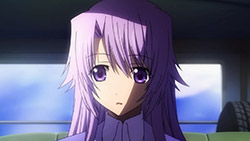 |
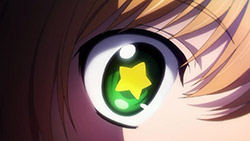 |
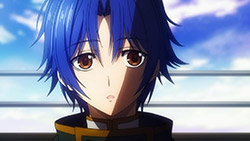 |
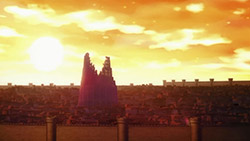 |
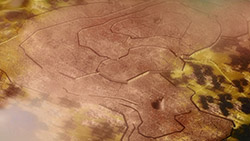 |
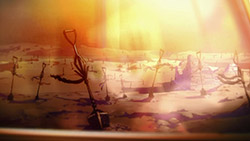 |
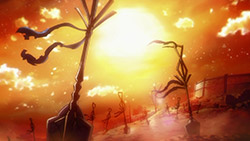 |
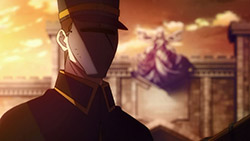 |
 |
 |
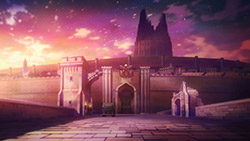 |
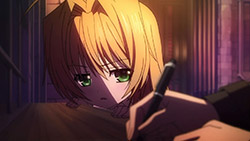 |
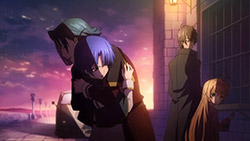 |
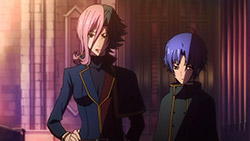 |
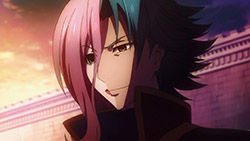 |
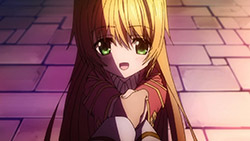 |
 |
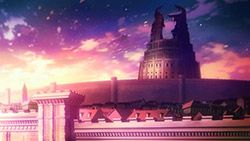 |
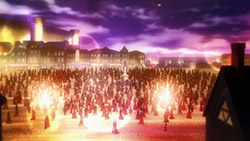 |
 |
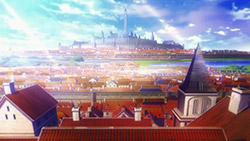 |
 |
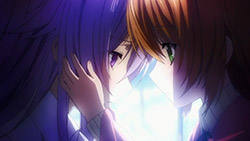 |
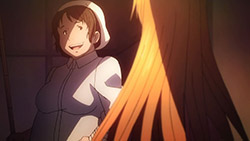 |
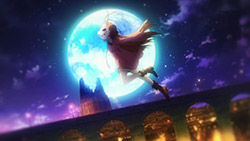 |
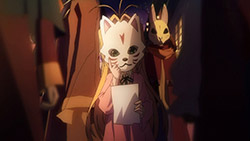 |
 |
 |
 |
「オルタスI」 (Orutasu I)
“Ortus I”
Well, isn’t this a convenient time for me to return? Fresh from the burial of a significant main character, Kaminai pushes its world-building narrative forward, revealing a world split (unintended pun) in so many ways. There still exist a large number of faults with the writing that would’ve probably made Stilts cringe, but this episode introduces some interesting symbols into the mix that give life and history to this death-ridden world.
Putting aside the fact that nobody has noticed the presence of two Gravekeepers in this huge city, guards and captains included, even though Kiriko (Tetsuya Kakihara) was able to notice at first glance, Ortus is an interesting place. Located presumably in the Francophone speaking region of Western Europe, it is remarkable that a city of this immense size could stay stable and peaceful in regards to the nature of its ever-degenerating population. In contrast to what you’d expect of a zombie town, Ortus is well maintained and orderly, with signs of culture such as plays and churches still very much active. The populace is ever active and mobile, and despite the need for the city’s inhabitants to wear masks to presumably hide their mortality, the friendly nature of the city is unhindered.
A particularly interesting note lies with the three major landmarks of Ortus, each with their own message about the city. The first we are prominently introduced to is the huge incomplete tower that looms over the otherwise well-maintained city. At least for myself, this tower reminds me of the Tower of Babel, a biblical structure that represented humanity’s failed desire to reach heaven directly from Earth. Those who are familiar with the story know how it ends–before the completion of the tower, God scatters the people of Babel across Earth and created separate languages for each group as to prevent them from rejoining one another to complete the tower. Perhaps the structure in Ortus serves as an unavoidable reminder of the curse that God placed on the world, of the abandonment and denial that their old deity placed upon them. While I myself probably would hate to be reminded of that every day, perhaps its constant reminder keeps the dead (and distant observers) in constant perspective of their current situation.
With this in mind, the second landmark–the main gate of Ortus–brings some interesting meaning to the table. When we are first introduced to the gate midway through the episode, with it is accompanied the images of many a Gravekeeper’s spear, presumably signifying the graves of their former owners. This display, along with the gate itself, shows no mercy to those who serve the grave, actively defying God’s will. While both Ai and Scar are in danger from this foreshadowing, it is Scar’s voices and slowly worsening condition that makes her situation all the more dire. Given how the show is unafraid of killing off characters, I wouldn’t be too surprised if Scar were to die off before the end of this arc. However, even more important than the gate itself is the monument to the “Idol of Death” above it.
Interestingly enough, the citizens of Ortus have not been jaded enough by irrational deities to not follow another one. I suppose in times of despair, it is comforting to take comfort in benevolent beings that promise you salvation, except the Idol of Death promises more protection from a forced deathbed than a reward in the afterlife. “She shall not allow the living to escape…she alone became the guardian of the dead.” states the last two lines of her description. Aside from providing more foreshadowing for the death of one of the main characters, it’s an interesting notion that the dead are actually being protected from the living/gravekeepers. In every type of zombie fiction (with perhaps exception to the recent Warm Bodies) , one singular notion always comes into play: humanity must survive at all costs against the zombie invasion. However, the tables are flipped here, where the dead have legitimacy to their existence, enough so that they have a rallying deity to unite their cause.
However, what deity at this point is to be trusted? How can the people of Ortus even know if this deity brings them the protection they desire? I’m sure the next few episodes will bring light to the topic, but already can we establish that something dark is looming behind all those masks people are wearing, specifically that of the princess. The third monument happens to be the government offices of Ortus, the gloomy looking castle that stands out from the otherwise warm-colored town, which houses the princess/savior of the dead. Instead of bringing universal hope, it seems that some people will not agree with this brooding plan–when Ai looks around the city in the morning, joy and wonder engulf her, but as soon as she lays eyes on that dreary castle, her expression displays concern. However, if I had to guess anything, the concern will ultimately not lie with what the princess will bring about, but rather what will happen to the princess herself, as is foreshadowed in the aptly named play, “The Idol of Murder and the Princess of the Dead.”
What new mysteries will the city of Ortus reveal to us in the next few episodes? Although hiccups in the story were distractions, I felt that the scope of the story brought some interesting plot points to put into motion, where the “chosen land for the dead” is the central theme. A new (and beautiful) adventure lies ahead in this massive city, and undoubtedly someone’s life will be put to rest by the end of it all. The question that now remains is who…and for what reasons will they die for.
Preview
 |
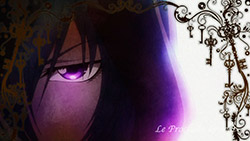 |
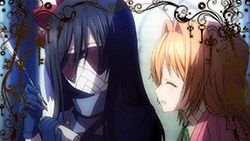 |

I feel this show is the dark horse of the season ;3
There’s just so much potential! 😀
Eagerly awaiting the things that will unfold…
Totally agree with and I’m loving this series so far.
For me, actually, this was the only series I had expectations on besides Monogatari this season. So far, it has mostly been living up to them, though, the death of Humpnie was a blow.
P.S : Kami Ni has a great musical score along with, great eye candy.
You are right this show is really awsome and this promise to be even more interesting, if Hampnie was right about how the dead degenerate then this city is going to have a horrible ending to say the least.
I wonder, how long can a dead live, before turning into a mindless zombie.
Hampnie said that the mental breakdown occours in about two months after being dead, the flesh takes a lot longer to decay.
I see. Thank you very much. 🙂
@haseo0408
“Hampnie said that the mental breakdown occours in about two months after being dead, the flesh takes a lot longer to decay.”
Might that be another plot hole? Or I might need some clarification. Let’s start here:
Everyone in Ai’s village was dead when her mother passed away. When Ai became a gravekeeper she was 7, now she’s 12. I thought it was outright stated the villagers remained as Deceased in order to take care of Ai. That was a period of five years before Hampanie arrived. The girl said no one died in the village after her mother passed away, so all these people were among the living-dead for years but they showed no signs of mental breakdown.
Another point is: Julie/Yuri lived together with his wife and child for quite some time. The wife was already dead for a while before Hampanie offed her. It was implied her mental state was okay.
Final point: Ortus is a massive city that was built for the Deceased. Surely it would’ve taken years instead of months to build such a grand urban center. I can’t imagine the living doing this on behalf of the dead.
So, does the mental deterioration start after two months, years or does it vary from person to person? When I watched this show, I got the feeling it was the latter. I just can’t buy the two months explanation with so many contrasts in the story.
I’m really enjoying this series but I can’t completely ignore those plot holes. If they’re not plot holes I just want to understand the plot points I might have overlooked. X_X
https://randomc.net/image/Kami-sama%20no%20Inai%20Nichiyoubi/Kami-sama%20no%20Inai%20Nichiyoubi%20-%2004%20-%20Large%2021.jpg
Umm, what the actual fuck?
I loved this episode, but there was 1 questionable moment….like whatever he/she is…and one boner provoking moment with Scar. Even so Great episode. I love how the story is unfolding so far 😀
Ai seems can’t sense dead people like Scar, is this because she is half human?
Rewatch the beginning of the episode. I believe she does state that she is half gravekeeper half human, but Yuri told her to keep it quiet.
https://randomc.net/image/Kami-sama%20no%20Inai%20Nichiyoubi/Kami-sama%20no%20Inai%20Nichiyoubi%20-%2004%20-%20Large%2033.jpg
Ai is really cute in that mask!
Yuri’s response to everything dangerous – Pull out a gun. Awesome.
Doesn’t anyone else think the VW Van is really weird?
What’s weird about it? The part I find interesting is they like this vehicle so much that they use it in this anime and another one.
https://randomc.net/image/Kami-sama%20no%20Inai%20Nichiyoubi/Kami-sama%20no%20Inai%20Nichiyoubi%20-%2004%20-%20Large%2012.jpg
The city reminds me a lot of the city in Shingeki no Kyojin. So many walls (more so than SnK’s). Marvelous scenery done by Madhouse as usual.
“with it is accompanied the images of many a Gravekeeper’s spear” I thought they used shovels :p
This episode was very interesting despite Humphrey dying last episode, and Scar seems to be developing emotion which means I’m going to be shipping her and Yuri :3
No matter how I look at it, they look like spears to me. Where is the curvature for them to even pick up the dirt! D:
I think the bit to pick up the dirt is buried in the dirt itself
One thing that I’m puzzled over is why did Scar joined Yuri and Ai on their journey? I understand Yuri’s reasons, but not Scar…
She might feel some sort of obligation towards a fellow Gravekeeper like Ai or perhaps some sort of curiosity of what will become of the product of the love between a Gravekeeper and a human. But my gut is telling me that Scar feels some sort of atachment towards Ai and she can´t explain it because she isn´t supposed to have emotions but she´s developing them never the less.
Poor Ai gets threatened by everyone. It is a wake up call for her to see the outside world and not just her own village. The real world is scary in many ways.
BTW, many people complained about the ED song last time because it seemed that the song was about lovers but we all got trolled!
Show Spoiler ▼
What I don’t really get is why is there a need to dump English words in Japanese songs just to confuse the listeners? The words don’t make any sense either.
My favourite engrish ED this season still goes to Ro-Kyu-Bu’s lyrics: “show you guts cool say what saikyou daze!” when it sounds like “shougakusei wa saikyou daze!”
This is a real example of humans cannot live without the existence of some sort of deity, we need something to rely on, something to ease our sufferings, something to help explain what cannot be explain, someone that gives the answers to questions with do not understand. So it´s almost predictable to see the dead replacing one god for another out of peace of mind.
The one that mostly stood out in this episode (aside from Scar in the bed) was the scenery of Ortus, really really drawn nicely, colors are so vivid…
That wasn’t the only thing that was standing up, if you know what I mean.
A magnificent Necropolis…
scar’s boobs? okay my day is complete 🙂
The first time I saw Kiriko I thought he was a Fire Emblem Character. Scar could sense all those dead people in Ortus from a distance, but did she know that Kiriko was in the van because he was dead or because it was just obvious. If it’s the latter, is Kiriko even dead? Scar said she wanted to bury those dead in Ortus, but mentioned nothing about wanting to bury Kiriko when she had the opportunity to do that. Maybe it’s a fault of the writing.
This guy is the red haired dude from the OP, what did he mean by the dark side of Ortus? Can you get darker than a city full of dead people that kills Gravekeepers who puts people to rest peacefully and most likely kill living people too?
What is it with this site and spoilers?!
The colour palette of this show is amazing. I love them contrasts – all that green and blue, in a city that is technically “dead” but filled with “life” if it can be called that.
Yay! FINALLY! Zanibas is blogging Kaminai.
Kinda different from the time you blog Oda Nobuna but.. oh well.
At least I get to see you POINT OUT things that aren’t easy to spot in one go and doing jokes.
Keep it up.
While one can argue (including me) that the writing has been a bit on and off so far, I think few can deny that this show is trying to build a fully realized world, and it’s making a very good job so far. One work of fiction (series, book, game etc.) can do many things right and wrong, but in my opinion, there is nothing like totally immersing you into its fictional world and mythos. I believe that Ortus city -and KamiNai in general- is one of the finest examples where the work of fiction attempts to “suck you in” its atmosphere; where it succeeds at making its fictional world alive and believable. I am loving it so far.
P.S.: Shingeki no Kyojin world immerses me just as much.
Scar’s boobs… Wanna see more.
I was suprsed to find out the blue haired boy of the OP song is called Kiriko. I had nicknamed him Bird-Boy in my head , and fully expected him to have a name relating to birds, like Tori(bird) or Karasu(crow). Maybe it is. I don’t know that much Japanese.And I don’t know what made me think that anyway ;P
I’m pretty sure that Scar is pregnant : She doesn’t have a fever + Ai existence + she hear a voice . Would be a good twist
Or maybe she is in love to whoever is whispering to her since the beginning of this episode.